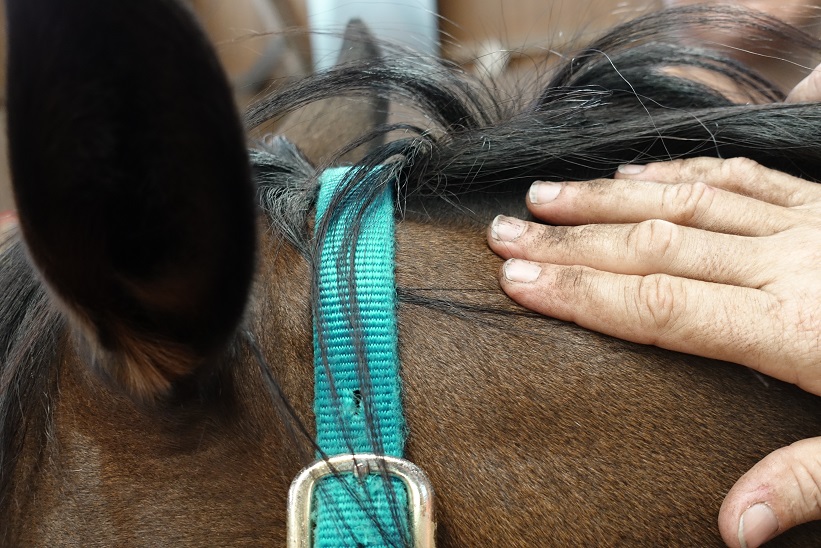Blogbeiträge von Pferdeosteopathie Handeloh
19.01.2023
Das Genick & die Halswirbelsäule des Pferdes
Das Genick und die Halswirbelsäule des Pferdes
Das Genick des Pferdes
Es beginnt am Kopf des Pferdes und endet am 2. Halswirbel. Der erste Halswirbel heißt Atlas, der zweite Halswirbel heißt Axis. Unter den obersten Halswirbeln liegt das Kiefergelenk.
Die Muskulatur um das Genick herum, wird als “die kurzen Nackenstrecker” bezeichnet. Das Nackenband (Funiculus nuchae) beginnt am Hinterhaupt und geht bis zum Widerrist des Pferdes.
Welche Muskulatur bewegt das Genick des Pferdes?
Die Nackenstrecker (oberhalb)
m. rectus capitis dorsalis major und minor (Kopfheber)
Die kurzen Nackentrecker
m. obliquus capitis cranialis und caudalis (Strecker und Dreher)
Die Nackenbeuger
m. rectus capitis lateralis und ventralis (Beuger des Atlas)
Die Halswirbelsäule des Pferdes
Die Halswirbelsäule des Pferdes besteht aus 7 Halswirbeln inklusive Atlas und Axis und verläuft S-förmig im unteren Drittel des Halses des Pferds. Oberhalb der Halswirbelsäule von den Spinalfortsätzen 2 bis 7 bis zum 1. Brustwirbel liegt die Nackenplatte (Lamina nuchae), darüber verläuft der Mähnenkamm. Die Nackenplatte ermöglicht eine kraftsparende Aufhängung des Kopfes bei der Streckung.
Das Nackenband geht über in das Rückenband, beides gemeinsam wird auch als Oberlinie des Pferdes bezeichnet.
Dehnt sich das Pferd nicht gegen den Zügel, kommt es zum sogenannten “falschen Knick”. Das Pferd kippt den Kopf einfach ab und dehnt sich nicht an den Zügel, dann knickt es zwischen dem 2. und 3. Halswirbel ab.
Dehnt sich das Pferd schlecht gegen den Zügel, bzw. lässt sich schlecht stellen, können immer auch die Zähne, das Zungenbein oder das Kiefergelenk die Ursache sein.
Eine korrekte Dehnung des Genicks nach links (Ohren auf gleicher Höhe, keine Verwerfung des Halses) bewirkt eine Dehnung der Muskulatur (Hals und Rücken) auf der rechten Seite.
Lässt sich das Pferd schlecht stellen, ohne dass es eine Einschränkung hat, empfehle ich Bodenarbeit oder richtiges Longieren ohne Ausbinder, um die Halsmuskulatur zu lockern.
Oftmals ist auch ein korrigieren der Zügelführung bei Reiter oder Reiterin der Schlüssel zur gesunden Bewegung des Pferdes.
—–
The horse’s poll and cervical spine
The horse’s neck
It starts at the horse’s head and ends at the 2nd cervical vertebra. The first cervical vertebra is called the atlas and the second cervical vertebra is called the axis. The temporomandibular joint lies under the top cervical vertebrae.
The musculature around the poll is referred to as “the short neck extensors”. The nuchal ligament (funiculus nuchae) starts at the back of the head and goes to the withers of the horse.
Which muscles move the horse’s neck?
The neck extensors (above)
M. rectus capitis dorsalis major and minor (head lifter)
The short neck stretchers
m. obliquus capitis cranialis and caudalis (extensor and rotator)
The neck flexors
m. rectus capitis lateralis and ventralis (flexor of the atlas)
The horse’s cervical spine
The horse’s cervical spine consists of 7 cervical vertebrae including the atlas and axis and runs in an S-shape in the lower third of the horse’s neck. Above the cervical spine from the spinal processes 2 to 7 to the 1st thoracic vertebra is the cervical plate (lamina nuchae), above which runs the crest of the mane. The neck plate enables the head to be suspended in an energy-saving manner when stretching.
The neck band merges into the back band, both together are also referred to as the top line of the horse.
If the horse does not stretch against the reins, the so-called “false kink” occurs. The horse simply tilts its head and does not stretch on the reins, then it buckles between the 2nd and 3rd cervical vertebrae.
If the horse stretches poorly against the reins or is difficult to position, the teeth, the hyoid bone or the temporomandibular joint can always be the cause.
Proper stretching of the poll to the left (ears level, no neck warp) stretches the muscles (neck and back) on the right side.
If the horse is difficult to position without being restricted, I recommend ground work or proper lunging without a rein to loosen the neck muscles.
Correcting the rider’s reins is often the key to the horse’s healthy movement.
#horseknowledge #anatomy #musculature #horseosteopathy #neck #atlas #axis #neckband #funiculusnuchae #horsetherapy #riding #kinetics #biomechanics #equestriansport #horses #horses #horsesofinstagram #instahorses #horse physiotherapy #muscles #joints #pferdewissen #anatomie #muskulatur #pferdeosteopathie #Genick #atlas #axis #nackenband #funiculusnuchae #pferdetherapie #reiten #bewegungslehre #biomechanik #reitsport #pferde #pferdephysiotherapie #muscles #gelenke
Susan Tenhaeff - 16:59 @ Pferdeosteopathie | Kommentar hinzufügen
